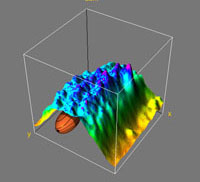Magnetic flow meter (MID)
In a project with Georg Fischer AG, I came to know for the first time about magnetic (inductive) flowmeters. The first thing I stumbled across was that the elctrostatic field was not conservative, when taking the "simple" theories, published in technical advertising journals as U = d x v x B. I then discovered that eddy currents build up, rendering the static field conservative, as it should be. The figure displays these eddy currents as well as the electric equipotentials for the case of a laminar flow and a homogeneous magnetic field, assuming infinite extensions.
Flow meter for ultrapure applications
The development of this flow meter was initiated by the company Levitronix and funded by KTI. I enjoyed very much having Markus Neuhaus as my scientific assistant. Thanks to his skills and commitment, we managed to fully achieve the goals of the project.
High speed Stereoscope
In order to determine the velocity distribution in the water jet of a water jet cutting facility, fluorescent PMMA-particles were monitored by an intensified high speed camera. The trick was to image two pictures stereoscopically onto a single camera, since we had no money for a second camera. The task was then to write software to localize the particles in the jet as well as determine their velocity. Collaborators: Andreas Vogel, Roger Kalt, Antje Arnold.
Determination of the Temperatur Profile in the Kerf during Laser Cutting
After claiming that this should not be too big a deal, I had to put it into practice. In consequence, I did another diploma thesis, together with the then student Philipp Roth.
Rolling Rugby Ball Background Subtraction
Thanks to the inventors of the Rugby Ball, the speed of the tiny sand grains in an abrasive water jet could be experimentally determined. My job was to develop algortihms that would locate the barely visible saind grains on the hundred thousands of pictures, taken by Dominique Sommer and colleagues.
Sound absorbing Glass
If everything goes well, sound absorbing glass panels will soon be available for ambitious architects. The work involved solving partial differential equations analytically and deducing practical design specs from these results. An important help was Sir Rayleighs book "the theory of sound", written more than a hundred years ago. I enjoyed the collaboration with research assistent Marco Bühlmann.
Another Project using Image Processing Algorithms
After we - Heinz Burtscher and I - got the key idea, this was more or less just regular work.






